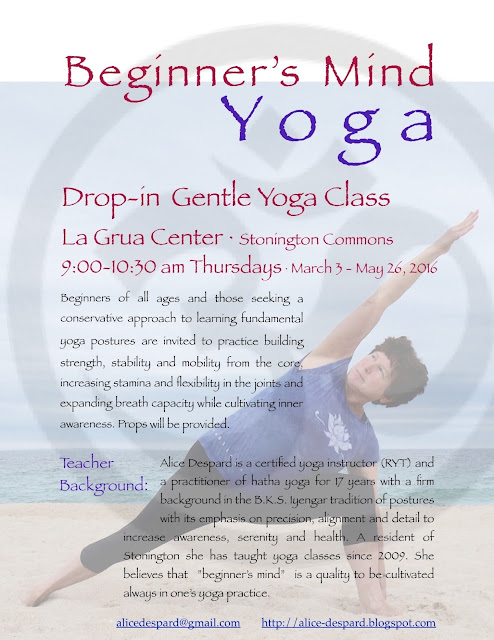Beginner's Mind Yoga
Alice Despard has been a practitioner of yoga for over over eighteen years primarily in the B.K. S. Iyengar tradition. She studied under Anne Wutchiett at Unity Woods Yoga Center in Bethesda,Maryland from 1997-2013 and began teaching yoga asana in 2007 (RYT). She believes that "beginner's mind" is a quality to be cultivated always in one’s yoga practice. This site will be a resource for students of yoga.
Sunday, February 26, 2017
Tuesday, October 4, 2016
Thursday, March 3, 2016
Monday, February 2, 2015
Friday, September 26, 2014
Monday, February 3, 2014
Upcoming Yin Yoga & Pranayama Workshop
Beginner's Mind Yoga presents:
Yin Yoga & Pranayama Workshop
Co-lead by Alice Despard (RYT-200) and Liz Chabra (ERYT-500)
When: Saturday, March 15, 2014 ~ 9:30 - 11:30 am
Where: Episcopal Church of the Redeemer
6201 Dunrobbin Drive
Bethesda, MD 20816
Cost: $35.00
Host: Alice Despard, Beginner's Mind Yoga Instructor
alicedespard@gmail.com
Preparing ourselves for the changing of the seasons as Spring approaches is a time-honored practice in the yoga tradition. Pranayama, which means "energy management", is an important tool in the yogi's toolbox. Working with the breath, pranayama helps us to optimize and regulate the flow of universal energy (prana) through our bodily systems, thereby supporting our immune system in pollen season as well as shaking off the sluggishness of the winter blahs.
The Yin postures in this workshop will focus on the lungs, heart and intestinal meridians. These postures, which are held for a length of time, encourage a meditative and receptive mind and so lend themselves perfectly to the introduction of breath work to begin stimulating the subtle energy body (pranamayakosha) which surrounds our physical body. In this workshop sequence, we will interweave Yin postures and breath work, followed by a short period of meditation to seal the practice.
Please bring your own mats and blankets if you have them and wear layers of clothing appropriate
for a yin practice oriented on the floor. We will also provide some blankets and other props.
Registration and payment in advance at this link is required to attend this workshop.
Sunday, June 23, 2013
The Subtle Benefits of Restorative Practice
I received a wonderful note from one of my yoga students today; here is the gist of it:
Solstice Full Supermoon June 22, 2013
This was great feedback for a yoga instructor to receive from a student; indeed feedback is what it is all about in a restorative practice:
The resistance to slowing down, listening quietly to the body is an endemic tendency with many go-go-go people. Some yoga practitioners have a rather narrow understanding of what they wish to achieve in a yoga practice: if it is not a sweaty "workout" it can't be a worthwhile practice. Of course sweaty, invigorating practice has its place! Very much so! A fiery, rajasic practice has many benefits, strengthening our bodies and our wills in many ways.
 By contrast, a restorative practice balances us out with a more sattvic, contemplative yoga practice, experiencing the body/mind complex in a radically different way. This can balance out our rajasic nature, which tends to be highly charged and zealous in its efforts, by bringing a cooling, calming, quieting influence by soothing the sympathetic and parasympathetic nervous systems in the body, and through cultivating the equanimity and dispassionate awareness of our higher witnessing self. Then your whole being begins to radiate with a more coherent and conscious light!
By contrast, a restorative practice balances us out with a more sattvic, contemplative yoga practice, experiencing the body/mind complex in a radically different way. This can balance out our rajasic nature, which tends to be highly charged and zealous in its efforts, by bringing a cooling, calming, quieting influence by soothing the sympathetic and parasympathetic nervous systems in the body, and through cultivating the equanimity and dispassionate awareness of our higher witnessing self. Then your whole being begins to radiate with a more coherent and conscious light!What this student is discovering is wonderful: yoga is indeed a practice of mind and body union, so that you become more able to isolate, (i.e. bring healing focus and awareness) to specific areas of the body which are calling for you to bring them back into wholeness--in fact, back into holiness.
Even those yoga students who are resistant to a restorative practice-- some consciously and some unconsciously--usually reap some profound benefits from a restorative asana class, sometimes to their own surprise!
Om Shanti Om
Subscribe to:
Posts (Atom)







